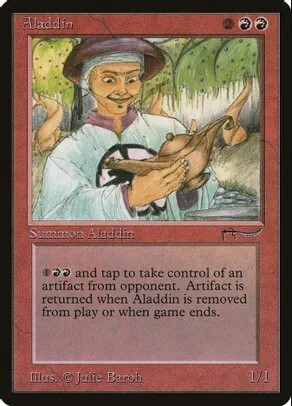8 Facts From The Early Days Of 'Magic: The Gathering Facts' That Will Tap Your Mana

The first set wasn’t actually called ‘Alpha’

Ask any old MTG head what the first set of cards was and they’ll reply “Alpha”. But when the very first Magic set debuted in 1993 it was actually just called Magic: The Gathering. As more and more cards were printed each year, the set became known as Alpha, with the next set officially titled Unlimited Edition, becoming known as Beta.
The game was hilariously small
Modern Magic players have access to over twenty thousand unique cards. Each year adds hundreds of unique new cards allowing for a game which is forever evolving (and draining our wallets.) But originally players only had a mere 306 cards to deck build with. Granted, some of those cards, like the power 9, are some of the most powerful cards ever printed, but still.
They used to get artists names wrong all the time
Considering there were only a few hundred cards and a handful of artists, you think they could have gotten their names right. But in the game’s 3rd edition, also called Revised Edition, alone there were several cards misprinted with the wrong artist attribution.

The backs of the cards were supposed to change every set
Originally, the designers of MTG wanted every set to function as a stand alone game. Each set would be functionally a whole new game with card backs to match. They wanted to imbue each set with flavor, a not-so-fancy term for narrative cohesion. People didn’t put their precious cards into sleeves often back then though, and the team realized with different card backs that you’d be able to tell which cards your opponent had a little too easily.
Early cards had bible verses on them
Instead of the flavorful world-building snippets of text we get on modern MTG cards, original printings of the set took quotes from real world sources. Durkwood Boars for example quotes Mark 5:13. And, very appropriately, Piety features a quote from the Qur’an. Other cards were printed with snippets from Dickinson, Poe, and even Shakespeare.
They straight up forgot to include some cards
When Alpha was first printed, no one knew what was missing because… no one had seen Magic cards before. But there were two cards that were one hundred percent supposed to be in the set. The first was Circle of Protection: Black. A card which feels very weird to not include because all of the other Circles of Protection (Circle of Protections? Surgeons General?) were printed in the set as intended. Same goes for another card: Volcanic Island. This dual land was totally left out, but both made it into the second round of printing. They’re honestly overpowered anyways…
There’s a reason we’ll probably never revisit Rabiah
Arabian Nights was an early expansion set in MTG. The plane was honestly pretty rad, it was inspired by ancient Middle Eastern fairy tales and was called Rabiah. Head designer Mark Rosewater even named the scale of how likely we are to revisit a plane in future sets after it. The Rabiah Scale gauges from one to ten what the chances are that WotC will print a set in a certain plane. Rabiah is unfortunately a 10, meaning we’ll almost certainly never go back. The reason? WotC doesn’t own any of the IP, for example… Aladdin.

If you lost, you had to give your opponent a card
Curating collections of Magic cards is something people spend years and sometimes thousands of dollars on. So giving away a card to an opponent seems unthinkable to most of us precious players nowadays. But when the game originally came out, it was built into gameplay by Magic’s creator Richard Garfield. Originally players would each RANDOMLY choose a card out of their deck and put it into the “ante zone”. Whoever won would take the spoils, leaving the loser to cry or gnash their teeth or however they expressed grief in the olden days of the early 90’s. Besides being wildly unpopular with players, there were concerns that the ante mechanic would bring too much legal heat onto the game. Legally, because there was a prize at stake with monetary value, the game could be considered gambling in official tournament settings. And that incurs fees and state by state restrictions that quickly become unwieldy. So it was relegated to history and they stopped printing cards with any ante-related text. Thank god they did, my precious Gitrog monster will never leave my side.
Hungry for more Magic? Check out this explainer on the biggest bads, this forgotten Sid Meier Magic game, and these raunchy Easter eggs hidden in MTG art!